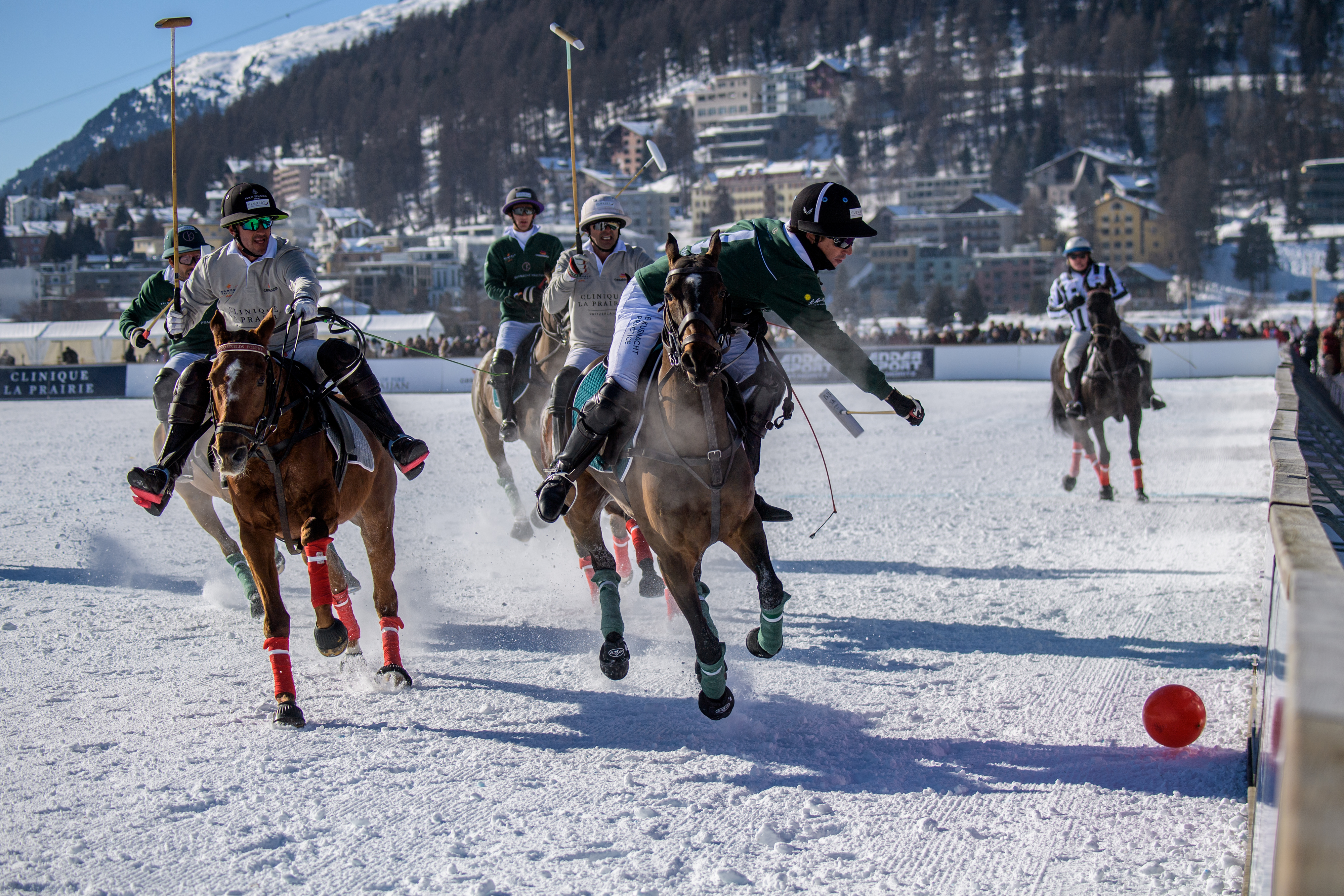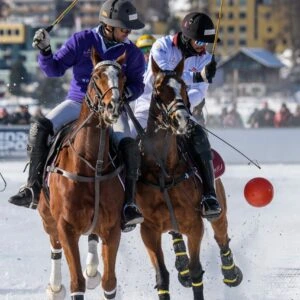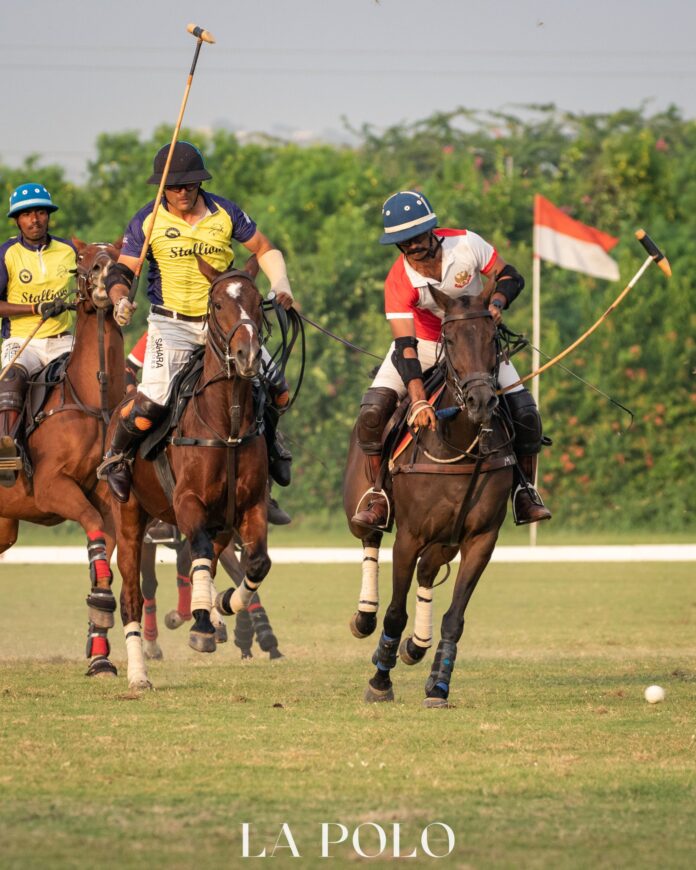Winter Polo, also known as Snow Polo, is a modern variant of Polo, which is played on compacted snow on flat ground or a frozen lake. The format of snow polo varies depending on the space available. Though different versions of polo have been played for more than 2,000 years, the first snow polo match was played in 1985. This historic event took place on a frozen lake in the Swiss resort town of St. Moritz. Over the decades, the popularity of the sport grew in Europe with games played in Italy, France, Austria, Spain, and Germany. Eventually, other countries, such as Argentina, Russia, and the United States, joined in on the snow polo craze. In 2011, China hosted Asia’s first snow polo game.
Rules of Winter Polo
The rules for snow polo are not very different from traditional polo, but there are some rules to be aware of if one plans on taking the sport to breathtaking snowscapes.
-
- Snow polo can be played on any level field that has been maintained and is firm. The dimensions are generally 87 yards wide by 218 yards long. The goal should be 23 feet wide, but there is no crossbar at the top.
- Two teams of players each are required to compete.
- The captain, who wears number 3, runs the strategy for the team. The back, who wears number 4, is responsible for defense. The other two players run attack plays.
- There are usually four to six periods, known as chukkas. They last for approximately seven and a half minutes, and the last period goes for seven minutes.
- The right of way is an essential rule of the sport. When the ball is in play, the player right on or at the smallest angle has the right of way. No player can position themselves on the line of the ball if there is a risk of collision. The player can only use their right of way when they are ridden off or hooked by another player.
While the rules and strategies are similar to regular polo, it’s essential to know the differences in order to win a game.

Equipment used in Winter Polo
The equipment used in Winter Polo is slightly different from traditional polo owing to the need to adapt to the colder temperatures and icy playing surfaces and to protect the players and the horses from the cold weather.
Some of the equipment used in winter polo include:
Snow Polo Mallets: Snow Polo mallets are typically made of a combination of wood, plastic, and metal that provides the necessary balance, strength, and weight to play the game on snow or ice. The mallets are typically shorter than those used in traditional polo, and they have larger heads to help the players hit the ball on the snow.
Polo Boots: The boots are typically made of waterproof material and have thick soles to keep the player’s feet warm and dry. These shoes provide extra grip on the icy surface which gives the player the necessary stability while playing.
Polo Helmets: The helmets are similar to traditional polo helmets, but they are typically lined with insulation to keep the player’s head warm.
Polo Gloves: The gloves used in the winter polo are typically insulated to protect the player’s hands from the cold.
Polo Rugs: Polo rugs are used to protect the horse from cold and snow. They are used to cover their back and legs.
Insulated Polo Blankets: Insulated Polo Blankets are used for the same purpose as Polo Rugs but are used more commonly as a second layer.
Snowshoes: Snowshoes may be used in place of regular horseshoes, they have a larger surface area to distribute the horse’s weight over a larger area, which helps prevent the horse from sinking into the deep snow.

Difference between Winter Polo and Normal Polo
The creators of snow polo attempted to keep as many of the rules and strategies as close to the regular version of the game. However, to accommodate the conditions, some changes needed to be made. The dimensions of an official international polo field are 200 yards wide by 300 yards long. But in snow polo, they are often 87 yards wide by 200 yards long. The changes reduce the physical strain on the ice compared to playing on grass. Games are also played with a big red ball to ensure that riders can see what they’re hitting. The balls are also a lot lighter and made of inflatable vinyl. A traditional polo ball is made with hard plastic. The rules and strategies that are applied to polo also apply in this game, but they need to be altered to suit the conditions and the differences of the game.
Dangers of Snow Polo
Snow polo is considered to be an extreme sport because of the accidents that can happen to players who fall off the horse onto the cold ice. The most common injuries that can occur are broken arms and collarbones. However, the rules of snow polo are stringent and are designed to avoid mishaps. The game not only seeks to protect the players, but also the horses. All of the horses are fitted with special shoes that contain grips, similar to cleats, so that they can provide extra traction on the ice and snow. In between periods, the horses are also covered with special blankets to keep them warm while they’re stationary and waiting for the game to recommence. As an extra precaution, the horses are flown in weeks before an event to allow them to get accustomed to the climate. Despite being considered an extreme sport, all the necessary precautions are made to ensure the safety of the riders and the horses. The rules of the game are designed to protect everyone on the field and reduce the risk of anyone getting hurt. But accidents can happen, and only professionals should play snow polo.
Winter Polo Championships
The location spawned the St Moritz World Cup and is considered by many as one of the most prized polo tournaments in the world. In addition to this competition, there is also the Polo Masters in Megeve, France, the World Snow Polo Championship in Aspen, Colorado, and Snow Polo World Cup in Kitzbuhel, Austria. Asia has also introduced the sport with the World Cup in Tianjin. While snow polo originated in Switzerland, it continues to grow in popularity outside of Europe, with more and more countries hosting games and events.






